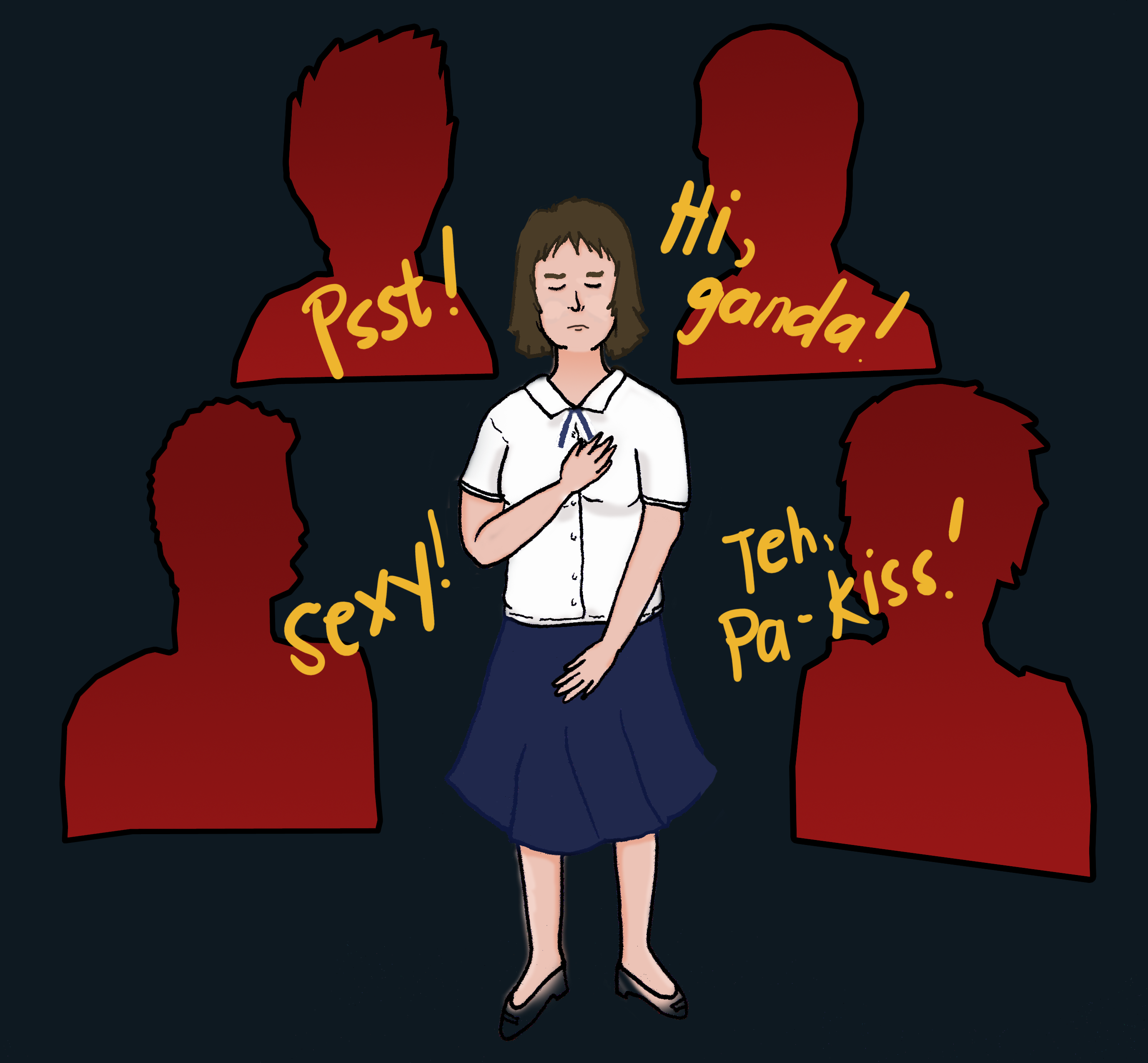
A SECOND home is how students would usually perceive their schools and universities, a safe space where they are nurtured intellectually and socially before venturing out in the real world. However, beyond the four walls of the classroom there remains greater threats—and that includes sexual harassment.
Recently, a Facebook post by a Geo Celestino narrated how his sister, College of Fine Arts and Design junior Yssa Celestino was reportedly harassed by a fellow Thomasian while she was on board an FX going home.
Celestino wrote that his sister took a blurred photo of her alleged molester and posted it on Twitter to raise awareness about sexual molesters lurking in public transport.
However, Celestino claimed his sister was “bullied” by the Student Welfare and Development Board (SWDB) under the Office of Student Affairs (OSA) when she was reportedly asked to apologize to her alleged harasser.
“Tapos, bigla na lang daw siya pinatawag ng UST SWDB. Her well-meaning gesture was being questioned,” the post read.
According to the post, the decision of the SWDB found her “guilty of falsely accusing another student of wrongdoing” under the Code of Conduct and Discipline (PPS 1027).
To air his grievance, Celestino wrote, “How many [are the] female (and male) students who were molested, asked for help, only to be blamed by the institution who swore to protect them?”
After the post went viral, the University of Santo Tomas (UST) released an official statement on Facebook, which refuted Celestino’s claims, saying they do not match with the University’s records, and details regarding the case were to remain confidential.
Netizens pointed out how, aside from being vague, UST’s statement failed to condemn the issue of sexual harassment.
As victims and their families show their growing concerns on students’ safety against sexual predators inside and outside the campus, are there policies in place to protect and support victims of sexual harassment?
Fear of judgment
A Journalism sophomore who requested anonymity narrated how she was harassed by her close friend—someone she thought she could trust.
“Inaya niya [akong] manood ng movie sa dorm niya… [Go] naman ako kasi trusted ko siya and malungkot ako that time kasi nahihirapan akong mag-adjust sa [university] life,” she said.
Much to her surprise, when the movie ended, he started making untoward advances. “He started forcing his face on mine para ma-kiss niya ako sa lips ko so of course I budged. Tumigil siya when he can’t get his way on me.”
Although she was shocked, she said she did not tell her family about what happened, fearing she will be blamed for her actions.
“Walang nakakaalam sa family ko. Baka kasi sa ’kin nila i-blame since uso [ang] victim-blaming ngayon. During breakdown ko kasi ‘yun noong hirap na hirap ako sa [academics]. Sasabihin lang nila ba’t kasi sumasama ako sa lalaki nang kaming dalawa lang,” she said.
Enveloped by fear of being judged, victims like her often choose to remain silent. This—apart from crying spells, withdrawal, avoidance, and expression of guilt—is very common for victims, and they often think self-defeating thoughts that lead to feeling of unworthiness, according to Faculty of Arts and Letters (AB) guidance counselor Adesty Dulawan.
Dulawan said there is a high probability that the victim will perceive the world as “very threatening, hostile, and violent.”
“It’s usually tri-part, it affects how they think, it affects how they behave, and it affects how they feel,” she added.
Meanwhile, UST Psychotrauma Clinic Supervising Psychologist Renz Christian Argao said that sexual harassment affects the victim “totally”—from loss of appetite, identity and interpersonal relations crisis, difficulty interpreting emotions, social isolation, to worst case scenarios such as Posttraumatic Stress Disorder and substance abuse.
On the part of the victim’s friends and family, Argao advised that they should avoid asking questions that will make the person feel like they are being judged, and that victim-blaming will only make them “withdraw from the truth about their experience.”
Likewise, Dulawan said that casting judgments before knowing the whole picture will only increase the difficulty of the victim to cope. “It’s already difficult, and then you blame the victim. It’s like an added pain; it’s nothing but an added pain.”
While victims remain subject to trauma and judgment, lawmakers and advocates are pushing for amendments to policies that safeguard the rights of the victims in public spaces, educational institutions, and in the workplace.
Amend to mend
In an interview with the Flame, Sen. Risa Hontiveros, Chair of the Senate Committee on Women, Family Relations, and Gender Equality, shared that she observed the drastically worsening situation of women regarding sexual and gender-based violence.
“I think it’s a common experience of women na biktimahin tayo or target-in tayo dahil sa gender natin,” Hontiveros opined. “‘Yung mga bagay na akala natin noon ay naipanalo na natin, like human rights [and] gender sensitivity, napaka-vulnerable pa rin pala.”
To address this pertinent vulnerability, Hontiveros filed the “Tres Marias” Bills, one of which will penalize online harassers, while two others that seek to amend the existing Republic Act (RA) 8353 or the Anti-Rape Law and RA 7877 or the Anti-Sexual Harassment Law.
Senate Bill (SB) 1250 or the Anti-Sexual Harassment Bill seeks to amend RA 7877 to include peer-to-peer offense and subordinate-superior harassment.
Section 3 of RA 7877 defines sexual harassment as an act “committed by a… person who, having authority, influence or moral ascendancy over another in a work or training or education environment… requires any sexual favor from the other, regardless of whether… requirement for submission is accepted by the object of said Act.”
Moreover, SB 1252 or the Anti-Rape Act seeks to amend RA 8353, “to emphasize the absence of consent as the essential element of the crime of rape,” among other amendments.
And with the rampancy of sexual harassment and abuse online, SB 1251 or the Gender-based Electronic Violence Act “seeks to prohibit and impose penalties on people behind misogynistic and homophobic attacks on social media.”
For Gabriela Partylist Spokesperson Hon. Arlene Brosas, it is high time to update the scope of cases considered as sexual harassment.
“Hindi na siya nababagay sa panahon ngayon kasi even ‘yung acts na ganito, nangyayari nang peer-to-peer. ‘Yung magkapantay lang kayo… In fact, nangyayari rin sa mas mataas pa sa ’yo, na ‘yung harassment coming from the ranks of halimbawa, student to teacher.”
The University follows RA 7877’s definition of sexual harassment, as written in the Student Handbook, and student-victims are advised to bring the matter to their respective deans, guidance counselors, and/or any University official who will endorse the matter to the Office of the Vice-Rector, where it will be acted upon “according to provisions of the Implementing Guidelines of RA 7877.”
Meanwhile, peer-to-peer offense falls under violations of decency of the Code of Conduct, and for such cases, a written complaint will be brought to the SWDB.
If both are from the same college, the local SWDB will take the case. Otherwise, the matter is brought to the Central SWDB and OSA, as explained by AB Asst. Dean Narcisa Tabirara in an interview with the Flame.
“There is no such thing as sexual harassment between peers. If it’s faculty against faculty, or student against student, hindi sexual harassment ang tawag don, ‘di ba?” Tabirara said.
Tabirara also added online sexual harassment is penalized under the Code of Conduct as it is considered as a “higher degree of cyber-bullying.”
Amid differences surrounding the implementation of anti-sexual harassment policies in private institutions like UST, University of the Philippines- Diliman Office of Anti-Sexual Harassment (UPD-OASH) Director Prof. Teresa Paula De Luna emphasized the role of schools as a social institution that greatly influences the minds of its students in pursuit of changing the outlook on gender sensitivity.
“Dito ‘di ba sa university natin, nalalaman natin na, ‘ah ang sexual harassment hindi pala ‘yung nagagandahan ka lang.’ Your intent is really to objectify women. Na sexual objects lang sila,” De Luna said.
Likewise, Brosas believes that the true improvement on confronting cases of sexual harassment comes from challenging social structures, through the application of step-by-step preventive measures through collective efforts and proper education.
Breaking the silence
Instead of keeping such an experience bottled up, Hontiveros encouraged victims to break their silence.
“The main message is you’re not alone,” she said. “Speak about your situation, your needs, your problem, [and] get help from people who care.”
As for support systems like friends and families, Dulawan reiterated the importance of listening to victims, because unloading their stories is already a form of therapy.
“At times, when we are facing someone who experienced such a traumatic experience, we get so anxious about saying the right words, but the thing is, we don’t have to say much. We just really have to listen,” she said.
Meanwhile, for Argao, awareness on how sexual harassment happens and how people should be helping those who have experienced it can lead to empowerment.
With this, he suggested that the University should consider doing campaigns for awareness for students, and gender sensitivity training for the faculty and staff. “Without knowledge on how to help people who are sexually harassed, you’re not going to help them, eh. You’re going to cause more harm sa kanila.”
And until there is an end to sexual harassment, the mark of such experience lingers, and victims like the Journalism sophomore is left to think, “I guess ‘di yata kumpleto [ang] pagiging babae hangga’t ‘di ka na-va-violate at least once.” F ALYSSA JOY E. PAYUMO and MINKA KLAUDIA S. TIANCGO



